Businesses today are under pressure to deliver seamless and efficient customer service experiences, no matter the time or channel. That’s where customer service automation with AI chatbots comes in. These advanced tools can handle routine inquiries, provide personalized assistance, and free up customer service agents to focus on complex tasks.
In this guide, you’ll learn how AI-powered chatbots are transforming customer support. We’ll cover their benefits, challenges, and best practices for implementation. Whether you’re a SaaS company, an SME, or an e-commerce business, this guide will help you enhance customer satisfaction, reduce operational costs, and streamline business operations.
What is Customer Service Automation?
Customer service automation uses technology to streamline support tasks, providing faster and more consistent responses to customer queries. This often involves leveraging tools like AI-powered chatbots and other virtual assistants to handle routine inquiries, automate repetitive tasks, and engage customers across multiple channels.
Instead of relying solely on human agents, businesses can use automation to improve the efficiency of their customer service teams. It allows support agents to focus on more complex issues, while AI handles tasks like answering frequently asked questions or resolving common customer inquiries.
By analyzing customer behavior and using customer data sources, AI can offer personalized responses and ensure consistent support. For instance, chatbots use natural language processing (NLP) to interpret customer inputs and deliver relevant responses in real time.
Key Features of Customer Service Automation
- 24/7 Availability: AI tools can provide support at any time, improving customer satisfaction.
- Efficient Handling of Routine Tasks: Automating routine inquiries and repetitive tasks reduces the workload on human support teams.
- Integration with Multiple Channels: Automation tools engage customers through messaging apps, social media platforms, and live chat systems.
- Cost Savings: Reducing the need for extensive human intervention lowers operational costs while maintaining a high-quality customer experience.
This approach not only enhances the customer journey but also supports business growth by ensuring faster responses and personalized assistance.
How AI Chatbots Power Customer Service Automation
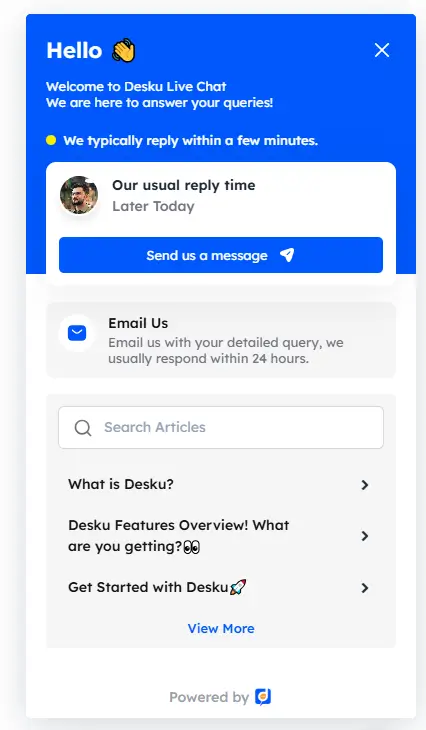
AI chatbots are the backbone of customer service automation, offering solutions that improve the efficiency of customer service teams while ensuring a smoother customer journey. These tools leverage advanced machine learning algorithms and natural language processing (NLP) to understand and respond to customer queries in an efficient manner.
Key Functions of AI Chatbots in Customer Service
- Answering Frequently Asked Questions: AI chatbots can handle routine inquiries, such as refund policies or product availability, offering quick and accurate responses.
- Providing Personalized Support: By analyzing customer data and past interactions, chatbots can deliver personalized responses that enhance customer engagement.
- Seamless Multilingual Support: AI chatbots can interact in multiple languages, making them ideal for global businesses.
Technology Behind AI-Powered Chatbots
- Natural Language Processing: Allows chatbots to understand the context and intent behind customer inputs, even if phrased in unexpected ways.
- Machine Learning: Enables chatbots to improve over time by learning from past interactions and customer behavior.
- Integration with Multiple Channels: AI chatbots operate across social media platforms, messaging apps, and websites, ensuring support is available wherever customers are.
Why Businesses Use AI Customer Service Chatbots
- Improved Customer Satisfaction: Faster responses and relevant information lead to better experiences.
- Automating Routine Tasks: Frees up human agents to address complex customer requests or urgent issues.
- Cost Savings and Revenue Growth: Reduces operational costs while increasing efficiency in business operations.
By understanding customer questions and delivering accurate support, AI chatbots ensure that customers feel heard and valued. They also serve as powerful tools to improve customer service and drive customer success.
Benefits of Using AI Chatbots for Customer Support
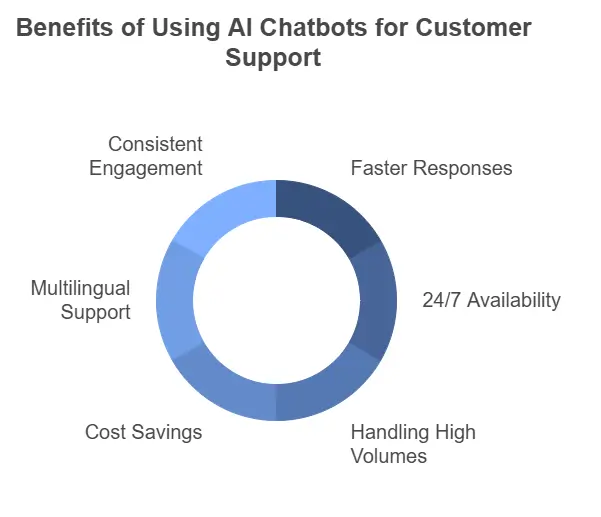
Implementing AI customer service chatbots can transform how businesses handle customer interactions. These tools provide a range of benefits that enhance the customer experience, streamline business operations, and reduce reliance on human agents for repetitive tasks.
1. Faster Responses to Customer Inquiries
AI chatbots ensure quick responses to customer questions by instantly accessing a knowledge base and delivering accurate support. This speed reduces wait times and improves customer satisfaction.
2. 24/7 Availability Across Multiple Channels
Unlike human support agents, chatbots provide assistance round the clock through messaging apps, websites, and social media platforms. This ensures customers always receive consistent support, even during peak hours or outside traditional business hours.
3. Handling High Volumes of Customer Queries
Chatbots excel at managing large numbers of routine inquiries without compromising response quality. This scalability makes them a valuable asset for businesses with high customer interaction rates.
4. Cost Savings and Efficient Resource Allocation
By automating routine tasks and reducing the need for extensive support staff, companies can lower operational costs. This allows human support agents to focus on complex issues or provide personalized assistance.
5. Multilingual and Personalized Support
AI chatbots with multilingual support engage customers in their preferred language, creating a global reach. By analyzing customer data and customer inputs, they offer tailored solutions, further boosting customer engagement.
6. Consistent Customer Engagement and Proactive Support
Chatbots can proactively guide customers through their customer journey, offering relevant information and addressing potential issues before they arise. This proactive approach strengthens customer relationships and builds loyalty.
How Chatbots Improve Customer Service
- Enhance the customer service experience by reducing errors and ensuring accurate answers.
- Assist in customer profiling by collecting and analyzing data from past interactions.
- Provide insights to improve service models and predict customer behavior.
These benefits demonstrate how AI-powered chatbots are not just a tool but a strategy for businesses to improve customer service and achieve revenue growth.
Challenges and Limitations of AI Chatbots in Customer Service
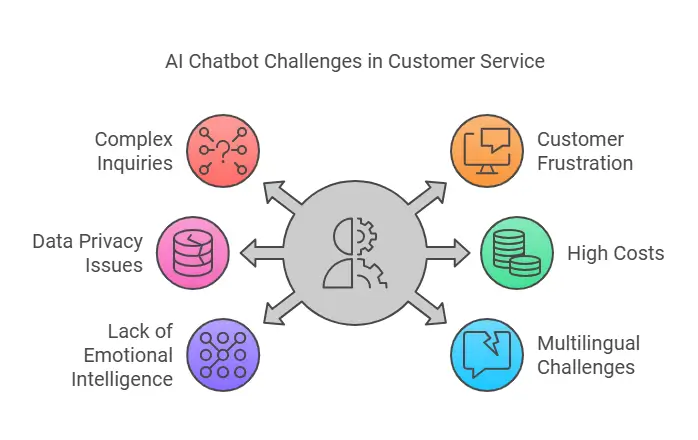
While AI-powered chatbots offer significant benefits, they also come with challenges that businesses must address to ensure smooth operations and maintain a positive customer experience.
1. Handling Complex Customer Inquiries
AI chatbots excel at routine tasks and answering frequently asked questions, but they can struggle with complex customer requests or inquiries requiring human judgment. For instance, resolving disputes or handling unique customer questions often requires escalation to human agents.
2. Customer Frustration with Limited Understanding
Despite advancements in natural language processing, chatbots may misinterpret customer inputs, leading to incorrect or irrelevant responses. This can result in frustration and negatively impact customer satisfaction.
3. Data Privacy and Security Concerns
AI chatbots rely on customer data to deliver personalized service, which raises concerns about data storage, security, and compliance with privacy regulations. Businesses must ensure that their customer service chatbot software adheres to data protection standards.
4. High Initial Investment and Maintenance Costs
Although chatbots reduce operational costs over time, the initial cost of customer service chatbot software, integration, and training can be a significant hurdle for SMBs. Regular updates and improvements also require ongoing investment.
5. Lack of Emotional Intelligence
Unlike human support agents, chatbots lack the ability to express empathy or build genuine connections during customer interactions. This limitation can hinder their ability to handle sensitive or emotional situations.
6. Multilingual Support Challenges
While many chatbots offer multilingual support, ensuring consistent quality across multiple languages can be difficult. Complex languages or regional nuances may require additional customization.
Overcoming These Challenges
- Use human support agents for complex queries and disputes that require empathy or in-depth understanding.
- Regularly train chatbots using advanced machine learning algorithms to improve their ability to interpret natural language.
- Ensure robust data encryption and compliance with privacy standards for secure customer data handling.
- Implement a hybrid model combining AI chatbots and human agents to offer the best of both worlds.
Addressing these challenges ensures that businesses can maximize the advantages of automation while maintaining a high-quality customer service experience.
Implementing AI Chatbots for Customer Service Automation
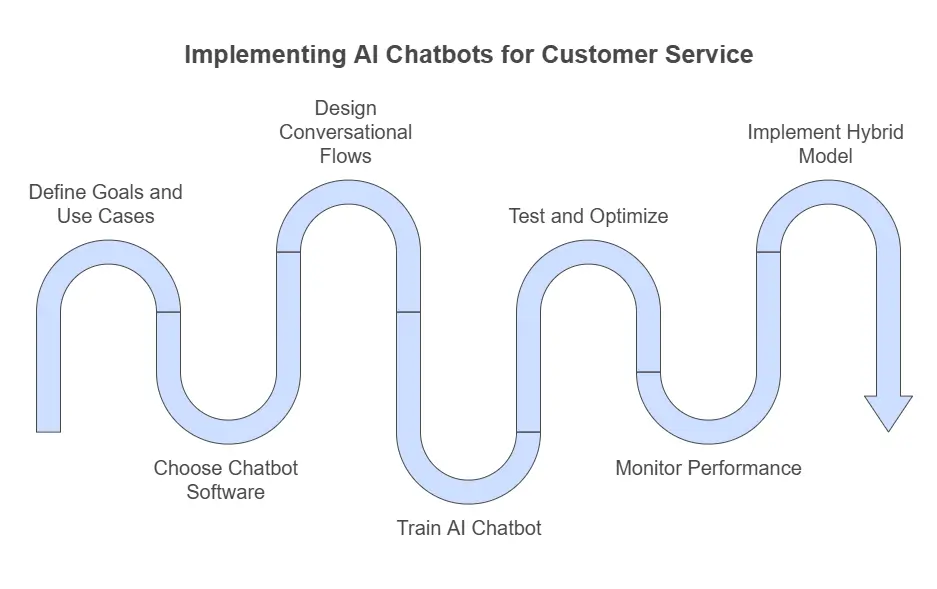
Adopting AI-powered chatbots requires careful planning and execution to ensure they align with your business goals and enhance the customer service experience. Here’s a step-by-step approach to implementing chatbots effectively.
1. Define Your Goals and Use Cases
Start by identifying what you aim to achieve with automation. For example:
- Automate routine inquiries to reduce response times.
- Provide personalized assistance for returning customers using customer data.
- Handle inquiries across multiple channels, such as messaging apps and social media platforms.
Clearly defining these goals ensures the chatbot meets the needs of your support team and enhances customer satisfaction.
2. Choose the Right Customer Service Chatbot Software
Select a platform that aligns with your needs. Look for features like:
- Natural language understanding for interpreting customer inputs accurately.
- Multilingual support to engage global customers.
- Integration capabilities with your CRM or existing knowledge base.
Popular tools often include advanced machine learning for better adaptability and personalized responses.
3. Design Effective Conversational Flows
Develop a clear structure for chatbot interactions:
- Focus on relevant responses to common customer questions.
- Build a smooth transition process to human agents for complex issues.
- Use predictive analytics to offer proactive support based on customer behavior.
4. Train Your AI Chatbot
Use advanced machine learning algorithms and past customer interactions to train the chatbot. This ensures it can handle diverse inquiries, recognize patterns in customer behavior, and provide accurate support.
5. Test and Optimize
Before launching, test the chatbot extensively. Gather feedback from the support team and beta users to refine:
- Accuracy of responses.
- Ability to understand natural language and nuances.
- Performance across multiple languages and platforms.
Regular optimization based on real-world data will help the chatbot improve continuously.
6. Monitor Performance and Gather Insights
Use metrics to evaluate the chatbot’s effectiveness, such as:
- Response time.
- Number of inquiries resolved without escalation to human agents.
- Customer satisfaction scores.
Analyze these insights to adjust and scale the chatbot’s capabilities, ensuring it consistently delivers value.
7. Implement a Hybrid Model (If Needed)
For tasks requiring empathy or deep problem-solving, combine the strengths of AI chatbots with human support agents. This hybrid approach balances efficiency with personal touch.
Proper implementation ensures your AI customer service chatbot becomes a reliable tool to streamline business operations, improve customer service, and drive revenue growth.
Best Practices for Customer Service Automation with AI Chatbots
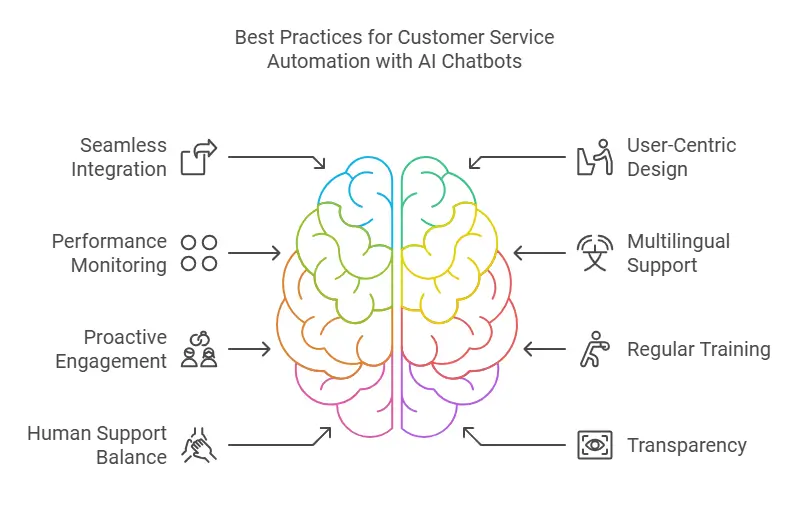
Implementing AI-powered chatbots effectively requires a thoughtful approach to maximize their benefits. Following these best practices ensures your customer service automation delivers value and enhances the customer journey.
1. Prioritize Seamless Integration with Existing Systems
Ensure your chatbot integrates with your CRM, knowledge base, and other tools. This allows it to access customer data, such as past interactions, and deliver personalized responses. A well-integrated chatbot provides consistent support across multiple channels, including messaging apps and social media platforms.
2. Focus on User-Centric Design
Create conversational flows that align with common customer inquiries:
- Address routine tasks like answering frequently asked questions with clear and simple language.
- Design escalation paths for complex queries, ensuring an easy handoff to human agents.
- Use natural language understanding to handle varied customer inputs accurately.
3. Monitor and Optimize Performance Regularly
Track key metrics such as:
- Resolution rates for routine inquiries.
- Speed of quick responses to customer questions.
- Customer satisfaction ratings after chatbot interactions.
Regular performance reviews help refine chatbot abilities, ensuring accurate and relevant responses.
4. Enable Multilingual and Multichannel Support
Equip your chatbot with multilingual support to cater to global customers. Ensure it can operate across multiple languages while maintaining consistency. Support across platforms like live chat, email, and social media platforms ensures broad accessibility.
5. Offer Proactive Support to Engage Customers
Leverage predictive analytics to anticipate customer needs. For instance:
- Send reminders for subscription renewals.
- Offer product recommendations based on customer behavior.
- Provide relevant information before it’s requested.
Proactive support not only enhances customer engagement but also contributes to improved customer satisfaction.
6. Train and Update Regularly
As customer preferences evolve, update your chatbot’s training using advanced machine learning algorithms. Continuously refine its ability to interpret natural language and address new trends in customer behavior.
7. Balance Automation with Human Support
For a well-rounded strategy, implement a hybrid model. Let chatbots handle repetitive and routine tasks while human support agents manage complex customer requests that require empathy or detailed problem-solving.
8. Communicate the Role of Chatbots Clearly
Make sure customers understand they are interacting with a virtual assistant. Transparency builds trust and sets the right expectations, especially when transitioning to human agents for complex issues.
Why These Practices Matter
By following these steps, businesses can:
- Provide accurate support with minimal errors.
- Enhance the overall customer service experience.
- Reduce operational costs while maintaining high-quality support.
These practices ensure your AI customer service chatbot becomes a valuable part of your support team, helping you deliver exceptional service in an efficient manner.
Real-Life Examples of AI Chatbot Success in Customer Service
Many businesses have transformed their customer service operations by adopting AI-powered chatbots, showcasing tangible benefits like improved efficiency, better customer engagement, and reduced operational costs. Here are some real-world examples demonstrating how AI customer service chatbots deliver value:
1. E-commerce Business: Managing High Volumes of Customer Queries
An e-commerce retailer implemented a customer service chatbot software to handle peak-season inquiries. The chatbot managed:
- Routine inquiries about order tracking and returns.
- Customer requests for product recommendations using past interactions and preferences.
- Multilingual support across multiple languages, enabling the brand to serve a global audience.
Results:
- Reduced response time by 60%.
- Freed up human agents to focus on complex customer requests.
- Increased customer satisfaction scores by 25%.
2. SaaS Company: Streamlining Customer Support
A SaaS company integrated an AI chatbot into its platform to assist with onboarding and troubleshooting:
- The chatbot provided quick responses to technical questions using an extensive knowledge base.
- It flagged complex queries for the support team, ensuring seamless escalations.
Results:
- 40% reduction in support tickets requiring manual resolution.
- Improved customer success metrics by offering personalized assistance at every stage of the customer journey.
3. SMBs: Cost Savings and Efficient Service
A small business adopted an AI customer service chatbot to automate routine tasks like answering FAQs and handling routine inquiries:
- The chatbot provided 24/7 assistance via messaging apps and social media platforms.
- It used natural language understanding to deliver relevant responses to inquiries.
Results:
- Lowered operational costs by 35%.
- Enhanced customer service experience by maintaining consistent and accurate support across multiple channels.
4. Travel Industry: Personalized Support for Complex Customer Requests
A travel agency implemented an AI-powered chatbot to provide tailored support for travelers:
- Offered real-time updates on bookings and itinerary changes.
- Used customer profiling and customer data to recommend personalized travel packages.
Results:
- Boosted customer engagement with proactive recommendations.
- Achieved 30% higher bookings through chatbot-assisted inquiries.
Key Takeaways from These Examples
- Businesses of all sizes can use chatbots to automate routine inquiries and improve the customer service experience.
- AI-powered chatbots enable scalability, allowing brands to handle diverse customer requests efficiently.
- A hybrid approach that combines chatbots and human support agents delivers the best outcomes for complex and emotional situations.
These success stories highlight how investing in AI customer service chatbot software can lead to measurable improvements in customer satisfaction, revenue growth, and overall efficiency.
Future Trends in Customer Service Automation
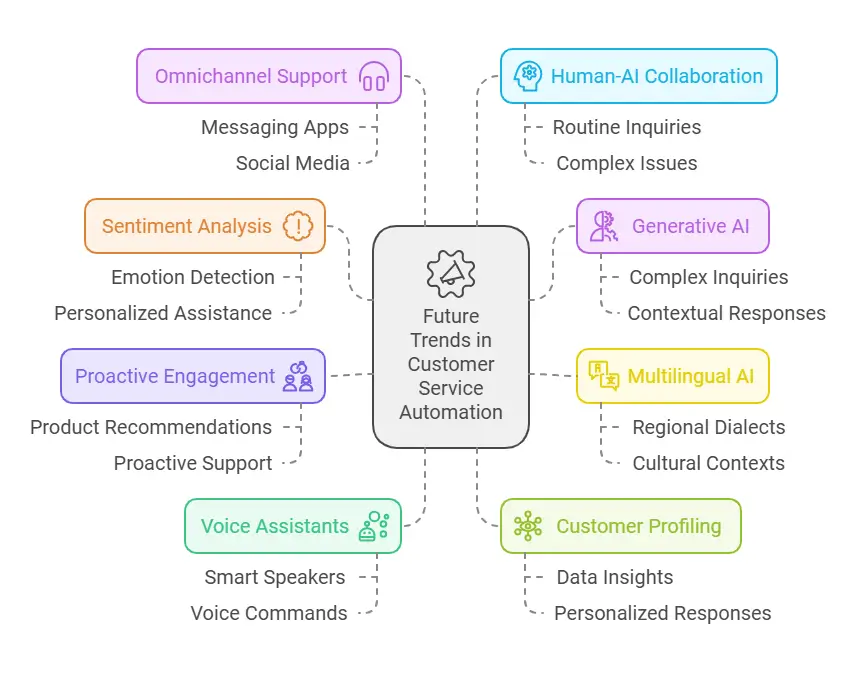
The future of customer service automation is driven by innovations in artificial intelligence and evolving customer expectations. Businesses that adopt these trends can offer a more seamless and efficient customer service experience while staying competitive.
1. Sentiment Analysis for Personalized Support
Emerging AI tools are focusing on natural language understanding to gauge customer emotions during interactions. By analyzing customer inputs, chatbots will be able to:
- Detect frustration or satisfaction.
- Adjust responses to provide personalized assistance.
- Escalate interactions to human agents for sensitive or emotional issues.
2. Generative AI for Complex Interactions
Generative AI models are enhancing AI customer service chatbots by:
- Handling complex customer inquiries with conversational depth.
- Generating tailored responses based on the context of the customer journey.
- Supporting open-ended questions with relevant information from large knowledge bases.
3. Multilingual AI Chatbots with Regional Nuances
While multilingual support is already common, the future will focus on greater accuracy in regional dialects and cultural contexts. AI chatbots will:
- Understand nuanced phrases in multiple languages.
- Deliver accurate support across diverse geographies.
4. Proactive Customer Engagement with Predictive Analytics
AI will increasingly leverage customer behavior data to anticipate needs. Examples include:
- Recommending products based on past customer interactions.
- Offering proactive support to resolve issues before customers ask.
5. Voice-Enabled Virtual Assistants
The rise of voice-activated technology will integrate with customer service automation:
- Customers will engage chatbots through smart speakers and voice commands.
- Enhanced natural language processing will make voice interactions seamless and accurate.
6. AI-Powered Customer Profiling
AI chatbots will use advanced machine learning algorithms to refine customer profiling. This will allow for:
- Deeper insights into customer data and preferences.
- More targeted and personalized responses during interactions.
7. Unified Omnichannel Support
Future AI-powered chatbots will provide consistent support across every touchpoint:
- From messaging apps to social media platforms, all interactions will be seamlessly integrated.
- This ensures a cohesive customer journey, reducing friction and improving customer satisfaction.
8. Human-AI Collaboration
The future of customer service teams lies in hybrid models where:
- AI manages routine and repetitive inquiries.
- Human agents focus on complex issues and building relationships.
- Collaboration ensures efficiency without sacrificing the personal touch.
Why These Trends Matter
- Businesses can achieve better scalability, reducing operational costs while improving customer interactions.
- Enhanced natural language processing and machine learning create more human-like interactions, boosting trust.
- Predictive and proactive support ensures customers feel valued throughout their journey.
Staying ahead of these trends ensures your customer service chatbot software delivers cutting-edge solutions, paving the way for long-term customer success and revenue growth.
FAQs About AI Chatbots for Customer Service
Here are some commonly asked questions about AI-powered chatbots and their role in customer service automation:
1. How much does it cost to implement AI customer service chatbot software?
The cost varies depending on the features, complexity, and scale of implementation. Basic chatbot software may start at $50/month, while advanced solutions with natural language processing and machine learning algorithms can cost hundreds to thousands of dollars, plus integration and maintenance fees.
2. Can AI chatbots fully replace human agents?
No, chatbots are best for automating routine tasks and handling repetitive inquiries. For complex issues and emotional interactions, human agents are irreplaceable. A hybrid approach—where chatbots handle simple tasks and escalate complex customer requests to humans—delivers the best results.
3. What industries benefit the most from customer service automation with AI chatbots?
Industries with high volumes of customer queries, such as e-commerce, SaaS, travel, healthcare, and finance, see significant benefits. AI chatbots streamline responses, reduce operational costs, and enhance customer satisfaction across these sectors.
4. Are AI chatbots secure for handling customer data?
Yes, but security depends on the implementation. Reliable AI customer service chatbot software follows strict encryption standards, ensures compliance with data protection laws, and limits access to sensitive information. Businesses should prioritize privacy to maintain customer trust.
5. Can AI chatbots handle multiple languages?
Yes, most modern AI-powered chatbots include multilingual support, enabling them to communicate in multiple languages. However, the quality of responses may vary for regional dialects or less common languages, which may require additional customization.
Conclusion
AI-powered chatbots are transforming customer service by automating routine tasks, providing quick responses, and delivering personalized assistance. They help businesses reduce operational costs, improve customer satisfaction, and free up human agents to focus on complex issues.
By integrating chatbots into your support strategy, you can enhance the customer journey, engage across multiple channels, and stay ahead in a competitive market. A hybrid approach combining automation with human support ensures the best results, making AI customer service chatbot software an essential investment for long-term growth.


